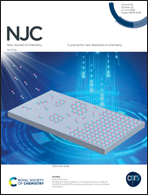In vitro and In silico anticancer activities of Mn(ii), Co(ii), and Ni(ii) complexes: synthesis, characterization, crystal structures, and DFT studies†
Abstract
The development of a potent metallodrug to prevent the progression of cancer is needed urgently. Here, three new complexes [Mn(pfth)2(o-phen)] (1), [Co(pfth)2(en)] (2) and [Ni(pfth)2(en)] (3) based on a 4-phenyl-(2-furoyl)-thiosemicarbazide (Hpfth) ligand containing 1,10 phenanthroline (o-phen)/ethylenediamine (en) as secondary ligands have been synthesized. The synthesized complexes have been characterized by various analytical, spectroscopic (IR, UV-vis., NMR), and single-crystal X-ray diffraction techniques. The results obtained by quantum chemical calculations (DFT and TD-DFT) agree with the experimentally observed values. The tumoricidal potential of Mn, Co, and Ni salts, ligand Hpfth, and their coordinate complexes was evaluated against K562, MCF-7, and DL cancer cell lines. Both short-term (XTT and MTT assays) and long-term (clonogenic assay) treatment of the tumor cells studied through colorimetric, clonogenic, and fluorescence-based assays by the complexes demonstrated true anti-tumor effects against these cancer cells. The results suggest the significant antitumor potential of the metal–ligand complexes against the tumor cells in a dose-dependent manner with higher growth inhibition, apoptosis, and inhibition in colony formation in comparison to either metal salts or free ligands. Complexes 1 and 3 induce more growth inhibition as compared to complex 2 against all cancer cell lines. Complex 3 demonstrated impressive tumoricidal properties in a clonogenic assay in comparison to complexes 1 and 2. These studies establish the role of metal centers in antiproliferative activities and reveal that Ni(II) exhibits more potent anti-tumoricidal activity. Molecular docking studies of Hpfth and complexes 1–3 were also performed against three target proteins 6NE5: Myeloid Cell Leukemia-1 (Mcl-1), 6E91: Carbonic anhydrase IX (CA IX), and 6H0W: Lysine Demethylase 4D and the results displayed favorable binding interactions.



 Please wait while we load your content...
Please wait while we load your content...